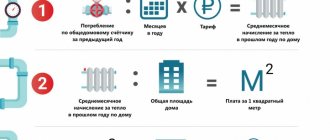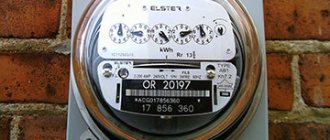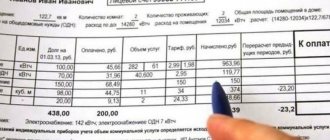Many of those who received receipts for services this year were very surprised at how impressive the amounts for heating turned out to be. Of course, when you designed the heating of an apartment and installed heating in a gas-type apartment, it was understood that the main costs would be only the installation of the system. Not long ago, new rules were established that explain the calculation of heating in an apartment. In addition, another additional line appeared in the receipt - ONE heating.
Apartment heating calculation
In this article we will help you determine how heating in an apartment is calculated. According to the new rules and standards of calculation, payment for any utility service, including heat energy, will be divided into several parts: payment for services provided in the residential premises, and payment for services provided for the general needs of the entire house. For this reason, the heating receipt will now have not only one line, but two.
Calculation
The procedure for calculating the heating bill will depend entirely on how the house is heated and what heating devices are installed in the room. There are several basic options for equipping a home with devices and appliances, which largely determine how heating in an apartment is calculated:
- In a residential building, only one device is installed, which is common, and in apartments and non-residential premises there are no metering devices at all.
- The house has a common device, which is needed to account for heating, but also individual rooms in the house are equipped with individual devices.
- The house completely lacks a common heating meter.
One of the options for installing a heat metering device
First of all, you need to find out if there is one common household appliance installed in the house, and also whether there are other individual heating metering devices in residential or non-residential premises.
Who sets heating tariffs in 2022?
Article 11 of the Law “On Heat Supply” states that prices for heat and its transmission can be set by the regulatory body (clause 1). In this case, single-rate and two-rate tariffs are applied. Prices are subject to change. They depend on the type of heat source and the distance over which the thermal energy is transferred. Price changes are also influenced by other parameters, which are described in the document called “Basics of pricing in the heat supply sector.”
Article 15 of this law states that heat consumers purchase it from the heat supply organization on the basis of a bilateral agreement. According to Article 2, the price for consumed heat is set by agreement of the parties, but it should not exceed the maximum permissible. In other words, the state sets only minimum and maximum price limits (Article 8, paragraph 1). Otherwise, the cost of the services provided depends on the supplier. The heat energy supplier includes all costs plus estimated profit in its price. This is mentioned in Article 7.
Example No. 1
One common device is installed in a residential building, and there are no individual devices in the premises. When deciding how to calculate heating in an apartment, we note that the payment for heating in a residential premises is carried out according to formula No. 3 of the Rules based on the readings of the individual heating meter installed in the apartment, or the heat consumption standard established for heating in residential premises type. All device readings are taken into account in Gcal.
- The volume of heat according to the data of the common house appliance was 250 Gcal.
- The total area of the house, which includes all apartments, as well as non-residential premises, is 7000 sq. m. meters.
- Apartment area – 75 sq.m. meters.
- The tariff for heat energy is 1,400 rubles. for 1 Gcal.
Heating calculations based on the area of the apartment will be made using the following scheme:
250 * 75 / 7000 * 1400 = 3750 rubles
This was the calculation of the first component of the receipt; the second component will be calculated using formulas No. 10 and No. 14. The first formula calculates the volume of the service, and the second formula calculates the amount of the fee in rubles. To determine the volume, you need to take into account the area of non-residential premises and apartments. For example, the size of the area is 6000 sq. meters.
The amount of heat will be produced by the following calculation:
250 * (1-6000 / 7000) * 75 / 6000 = 0.446428571 Gcal.
After these calculations, you can calculate the heating fee:
3750 + 625 = 4375 rub.
Installation of a heat meter in the basement of an apartment building
Innovations
On July 19, 2022, a number of amendments were adopted to the law “On Heat Supply”. The main purpose of these changes is the transition from state management to negotiated prices. What exactly has changed in the legislation?
| Article | Old version | New option |
| Art.2 p10 | The program of investment projects of organizations involved in heat supply involves connecting consumers to the heat supply system. | The program of investment projects of organizations involved in heat supply involves connecting consumers to the heat supply system. This program is not being developed in price zones. |
| Art. 2p18a | It is permissible to set a price by agreement of the parties . | The price is set strictly as a result of the agreement of the parties, but cannot exceed the maximum permissible level |
| Art. 2p18b | The process of transferring thermal energy is regulated by the state | The process of transferring thermal energy is regulated by the state, but in some cases the price is acceptable by agreement of the parties |
| Article 15ch9.3 | Management organizations that receive heat for public services are required to pay fees on time, otherwise they will be charged penalties. | Management organizations that receive heat under a heat supply agreement are required to pay fees on time, otherwise they will be charged penalties. |
Example No. 2
There is one common appliance installed in the house, and there are also individual appliances in some residential or non-residential premises. Payment for heating in the apartment will be made according to formulas No. 1 and No. 2.
Autonomous heating in the apartment
According to formula No. 1, the calculation will be made using the following method:
1.5 * 1400 = 2100 rubles
- 1.5 is the volume of heat in Gcal, which was taken from what the individual device shows;
- 1400 rubles is the tariff for payment of 1 Gcal of heat;
According to formula No. 2, the calculation is carried out in the following way:
0.025 * 75 * 1400 = 2625 rubles
- the number 75 is the area of the apartment;
- 0.025 Gcal – norm of heat consumption per 1 sq.m.
How to calculate the heating in an apartment, in this case, will depend on whether the apartment has an individual device for metering the heat consumed. The second component of the receipt will be calculated using formulas 10 and 13. The first component will be used to calculate the amount of payment for heat, and the second component will be the volume of services.
(250 – 10 -5000 * 0.25 – 8 -30) * 75 / 6000 = 0.9625 Gcal
Some unknown indicators include:
- 10 Gcal – the volume of thermal energy that was consumed in non-residential premises;
- 5000 sq. m. – total area of all apartments;
- 8 Gcal is the amount of heat that was consumed in the apartments. Data is taken from individual devices.
- 30 Gcal is the amount of heat that is needed for hot water supply if there is no centralized heating distribution in the apartment.
To calculate the cost of payment in rubles, we multiply the volume by the established heat tariff:
0.9625 * 1,400 = 1,347.50 rub.
The full payment for heating the apartment will be calculated using this method:
2,100 + 1347.50 = 3,447.50 – if the apartment’s heating system has an individual device;
2,625 + 1,347.50 = 3,972.50 rubles. – if there is no device in the apartment.
Installing a heat meter in an apartment
Regulations
In 2010, a law was passed that regulates all heat issues. It’s called “On Heat Supply” (07/27/2010). The main points of this document are:
- basic concepts;
- distribution of responsibilities of government bodies;
- government approach to pricing;
- relations between heat suppliers and customers;
- work on the quality of heat supply;
- price zones and their features;
- self-governing enterprises;
- rights to heat supply facilities.
Ordinary consumers are concerned only with the first six points. The structure that controls the heat supply is the Federal State Energy Supervision Authority. Antimonopoly control is assigned to the Antimonopoly Committee. The first authority in which an ordinary consumer can resolve heat-related issues of interest to him is the local authorities of administrative units.
Attention
Article 7 of the above document talks about the main approaches to setting prices and tariffs for heating in 2022. The main directions are accessibility for citizens of the state, feasibility from an economic point of view, stability. Part 6 is especially important in this article. It talks about the availability to the population of information related to heat pricing.
Many questions related to the formation of heating tariffs in 2022 are answered by Article 8. It discusses the types of payments that apply to ordinary consumers. Among them:
- tariffs for substances used for heat transfer;
- water heating fee;
- heat transportation services;
- maintaining thermal power in working condition during non-working periods.
The regulation of heat supply tariffs is based on the economic justification of costs, indexation, and ensuring profitability.
The second document relating to heat is the Federal Law of November 23, 2009 No. 261-F3 “On energy saving and increasing energy efficiency and on introducing amendments to certain legislative acts of the Russian Federation.” This law mainly concerns consumers in two chapters:
- Chapter 2 describes the powers of state authorities and local governments in the field of heat supply.
- Chapter 3 describes regulations, efficiency and heat metering.
Calculation by individual meter
According to the law, in facilities recognized as residential, commissioned after 2012 or undergoing major renovations, all apartments are provided with individual heat energy meters. Then the owners pay for heating not according to general standards, but according to the readings of dedicated meters.
Until 2015, this rule applied to homes in which each apartment was equipped with a separate appliance. In the absence of at least one owner, all tenants were obliged to make payments in accordance with the testimony of the ODPU. However, in 2015, by the decision of the Constitutional Court, this rule was canceled, although not all utilities recognize this.
Calculation of the payment amount for individual meters with an additional amount for the house
To carry out calculations you need to know the following indicators:
- P – the amount of heat energy consumed according to the indicators of the allocated meters;
- Rodpu – consumption according to a common house meter;
- Ronp – total energy consumption for heating non-residential premises;
- P – area of each individual property;
- Po – quadrature of all premises;
- T – tariff rate for payment of 1 Gcal of energy.
Calculation:
O = (P+Ronp x P/Po) x T
Example
Technical data:
- P – 40m2;
- Rodpu – 135 Gcal;
- P – 0.86 Gcal;
- Po – 5200m2;
- T – 1747.45 rub/Gcal.
First you need to calculate Ronp. Rodpu – 135 Gcal, R – 120 Gcal. Therefore, Ronp = 135-120 = 15 Gcal.
O=(0.86+15 x 40/5200) x 1747.45 = 1704.43 rub.
Nuances
Heat consumers should pay attention to the fact that hot batteries in 2022 are no longer a state monopoly. Heat energy suppliers are commercial organizations whose purpose is to make a profit. They supply hot water to taps and radiators on a contractual basis. The only criterion that inhibits their appetites is the limit set by the state. Based on their commercial interests, heat suppliers charge full fees for repairs and maintenance of coolants in the summer. This is a harsh reality confirmed by law.
Comments Showing 0 of 0
Payment for heating in the absence of centralized heating
Installing your own heating boiler in an apartment does not contradict the law if all conditions for redevelopment of the premises are met. This is a very labor-intensive procedure, because disconnection from the central heating network is regarded as reconstruction of common property. Owners decide to take this step in order to save on heating bills. However, until recently, the law obliged such individualists to pay for utilities in full, and not just for common premises.
In 2022, the Constitutional Court ordered the Government to make adjustments to the Rules for the provision of public services and to develop an adequate scheme for calculating fees for autonomous heating. Until the changes are adopted, owners will have to pay double for heating.
Calculation of heating fees using a common house meter
According to Government Decree No. 354, heating payments are divided into two types:
- for the living space of the person who is the owner;
- for general house needs, which include heating stairwells, attics and basements.
To calculate the amount for heating in an apartment building with a residential building, you need to find out from the management company the total square footage of the premises in order to calculate the share of each owner in the total energy consumption supplied to the residential property.
Formula for proportional distribution of payment according to the indicators of the common house meter
A simplified calculation of the cost of heating a house equipped with an ODPU consists of the following indicators:
- P – area of the payer’s apartment;
- Po is the total square footage of the building’s premises;
- T – cost of 1 Gcal according to the tariff;
- P – heat energy consumption according to ODPU readings;
- O – payment amount.
Calculation formula:
O=P x P/Po x T
Example
Technical data:
- P – 40 m2;
- Po – 5200m2;
- R – 135 Gcal;
- T – 1747.45 rub/Gcal.
O = 135 x 40/5200 x 1747.45 = 1814.66 rubles/month.
The cost of heating communal premises is higher than that of residential premises. However, when the amount is broken down among all the owners living in the house, the total amount is reduced. Both balances must be included in the heating receipt.
Important! The terms of payment for heating residential and non-residential premises must be included in the terms of the agreement with the management company.
How is payment calculated without metering devices?
Seasonal heating fees affect the amount of utility bills. The question of how to check the accuracy of the accrual is of interest to many homeowners, especially those who do not have dedicated meters.
In accordance with the Federal Law “On Heat Supply” No. 190-FZ dated July 27, 2010, heat energy supplied under a service agreement must be subject to commercial accounting. House-wide meters are now installed on all heat-conducting communications being put into operation. However, heating networks of houses built more than 10 years ago may not have such equipment. For such objects, commercial accounting of heat consumption is carried out by calculation.
Payment formula according to consumption standards
To check your heating bill, you need to know the values of the components of the calculation scheme, namely:
- P – area;
- T – cost of 1 Gcal of energy according to the regional tariff. This is official information that can be found on the website of the management company servicing the house;
- N – heat standard for heating 1 m2 of living space (Gcal/m2). The indicator depends on the weather conditions of the region, the year the home was built and the material of the walls;
- О – payment amount for heating.
Attention! Tariff rates are set by the State, and consumption rates are set by a special commission.
Heating payment calculation scheme:
O=P x N x T
Example
As an example of calculating payment, let’s take a one-room apartment with the following parameters*:
- P=40m2, house built in the period 1980-1999 with brick walls;
- T=1747.45 rub/Gcal. The tariff rate was adopted for the period from 01/01/2019 to 06/30/2019 by the St. Petersburg Tariff Committee;
- H=0.0215 Gcal/m2. Information is publicly available on the Committee's website;
- О=40 x 1747.45 x 0.0215=1502.81 rub.
*calculations for other heating payment schemes will be made using the same example.
Attention! If it is possible to install commercial heat metering devices, but the owner or management company refuses to do this, an increasing factor may be used when issuing an invoice for heat.











